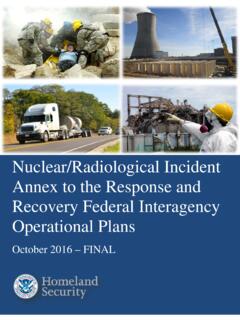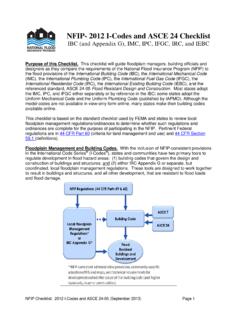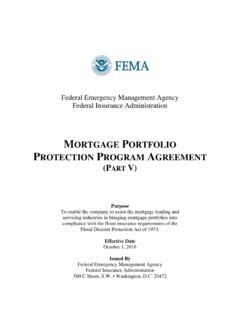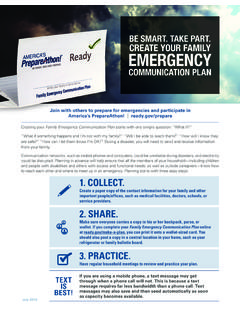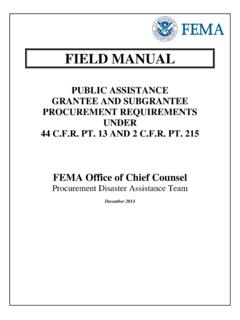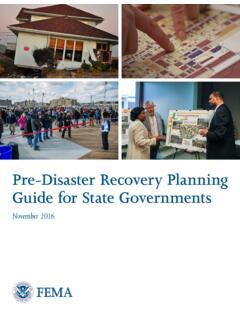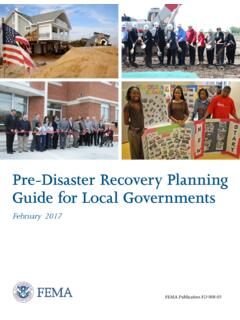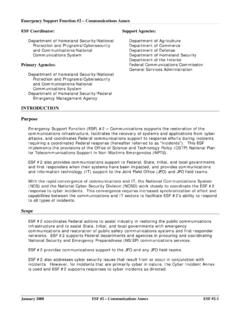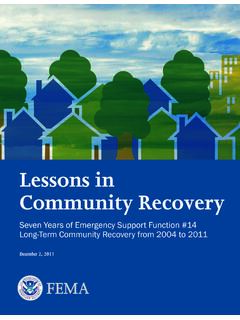Transcription of Developing and Maintaining Emergency Operations Plans
1 November 2010 Comprehensive Preparedness Guide (CPG) 101 Version Developing and Maintaining Emergency Operations Plans I am pleased to announce the release of Version of Comprehensive Preparedness Guide 101: Developing and Maintaining Emergency Operations Plans . Comprehensive Preparedness Guide (CPG) 101 provides guidance for Developing Emergency Operations Plans . It promotes a common understanding of the fundamentals of risk-informed planning and decision making to help planners examine a hazard or threat and produce integrated, coordinated, and synchronized Plans . The goal of CPG 101 is to assist in making the planning process routine across all phases of Emergency management and for all homeland security mission areas. This Guide helps planners at all levels of government in their efforts to develop and maintain viable, all-hazards, all-threats Emergency Plans . Based on input from state, territorial, tribal, and local officials from across the United States, this update of CPG 101 expands on the fundamentals contained in the first version.
2 With this edition, greater emphasis is placed on representing and engaging the whole community to include those with access and functional needs, children, and those with household pets and service animals. Residents and all sectors of the community have a critical role and shared responsibility to take appropriate actions to protect themselves, their families and organizations, and their properties. Planning that engages and includes the whole community serves as the focal point for building a collaborative and resilient community. CPG 101 is the foundation for state, territorial, tribal, and local Emergency planning in the United States. Planners in other disciplines, organizations, and the private sector, as well as other levels of government, may find this Guide useful in the development of their Emergency Operations Plans . While CPG 101 maintains its link to previous guidance, it also reflects the reality of the current operational planning environment.
3 This Guide integrates key concepts from national preparedness policies and doctrines, as well as lessons learned from disasters, major incidents, national assessments, and grant programs. W. Craig Fugate Administrator, Federal Emergency management Agency This page intentionally left blank. Preface Comprehensive Preparedness Guide (CPG) 101 provides Federal Emergency management Agency (FEMA) guidance on the fundamentals of planning and Developing Emergency Operations Plans (EOP). CPG 101 shows that EOPs are connected to planning efforts in the areas of prevention, protection, response, recovery, and mitigation. Version of this Guide expands on these fundamentals and encourages Emergency and homeland security managers to engage the whole community in addressing all risks that might impact their jurisdictions.
4 While CPG 101 maintains its link to previous guidance, it also reflects the reality of the current operational planning environment. This Guide integrates key concepts from national preparedness policies and doctrines, as well as lessons learned from disasters, major incidents, national assessments, and grant programs. CPG 101 provides methods for planners to: Conduct community-based planning that engages the whole community by using a planning process that represents the actual population in the community and involves community leaders and the private sector in the planning process Ensure Plans are developed through an analysis of risk Identify operational assumptions and resource demands Prioritize Plans and planning efforts to support their seamless transition from development to execution for any threat or hazard Integrate and synchronize efforts across all levels of government.
5 CPG 101 incorporates the following concepts from operational planning research and day-to-day experience: The process of planning is just as important as the resulting document. Plans are not scripts followed to the letter, but are flexible and adaptable to the actual situation. Effective Plans convey the goals and objectives of the intended operation and the actions needed to achieve them. Successful Operations occur when organizations know their roles, understand how they fit into the overall plan , and are able to execute the plan . This Guide is part of a series of CPGs published by FEMA. CPG 101 discusses the steps used to produce an EOP, possible plan structures, and components of a basic plan and its annexes. CPGs provide detailed information about planning considerations for specific functions, hazards, and threats. CPG 101 is the foundation for state, territorial, tribal, and local Emergency planning in the United States.
6 Planners in other disciplines, organizations, and the private sector, as well as other levels of government, may find this Guide useful in the development of their EOPs. i Comprehensive Preparedness Guide 101 ii This page intentionally left blank. Contents INTRODUCTION AND OVERVIEW .. INTRO-1 Purpose .. Intro-1 Applicability and Scope .. Intro-1 Supersession .. Intro-2 How to Use This Guide .. Intro-2 Suggested Training .. Intro-2 national incident management system Implementation .. Intro-2 Administrative Information .. Intro-2 Revision Process .. Intro-3 1. THE BASICS OF PLANNING .. 1-1 Overview .. 1-1 Planning Fundamentals .. 1-1 Planning Principles .. 1-1 Strategic, Operational, and Tactical Planning .. 1-4 Planning Approaches .. 1-5 plan Integration .. 1-6 plan Synchronization .. 1-7 Common Planning Pitfalls .. 1-7 Planning Considerations .. 1-8 2. UNDERSTANDING THE PLANNING ENVIRONMENT: FEDERAL, STATE, AND LOCAL Plans .
7 2-1 Overview .. 2-1 Relationship Between Federal Plans and State Emergency Operations Plans .. 2-1 The national incident management system .. 2-1 The national Response Framework .. 2-2 Federal Emergency Plans at the national and Regional Levels .. 2-4 State, Territorial, and Tribal Emergency Operations Plans .. 2-5 Local Emergency Operations Plans .. 2-5 Linking Federal, State, and Local Emergency Plans .. 2-6 3. FORMAT AND FUNCTION: IDENTIFYING THE RIGHT plan FOR THE JOB .. 3-1 Overview .. 3-1 The Emergency Operations plan .. 3-1 State and Local Emergency Operations Plans .. 3-2 Structuring an Emergency Operations 3-3 Traditional Functional Format .. 3-4 Emergency Support Function Format .. 3-5 Agency-/Department-Focused Format .. 3-7 Using Planning Templates .. 3-9 Additional Types of Plans .. 3-9 Procedural Documents .. 3-10 Emergency Operations plan Content .. 3-12 The Basic plan .. 3-12 iii Comprehensive Preparedness Guide 101 iv Supporting Annexes.
8 3-15 Hazard-, Threat-, or incident -Specific Annexes .. 3-18 4. THE PLANNING PROCESS .. 4-1 Overview .. 4-1 Steps in the Planning Process .. 4-1 Step 1: Form a Collaborative Planning Team .. 4-2 Step 2: Understand the Situation .. 4-7 Step 3: Determine Goals and Objectives .. 4-11 Step 4: plan Development .. 4-12 Step 5: plan Preparation, Review, and Approval .. 4-16 Step 6: plan Implementation and Maintenance .. 4-25 APPENDIX A: AUTHORITIES AND REFERENCES .. A-1 APPENDIX B: LIST OF ACRONYMS AND GLOSSARY .. B-1 APPENDIX C: Emergency Operations plan DEVELOPMENT GUIDE .. C-1 APPENDIX D: SUGGESTED TRAINING .. D-1 Introduction and Overview Purpose Comprehensive Preparedness Guide (CPG) 101 provides guidelines on Developing Emergency Operations Plans (EOP). It promotes a common understanding of the fundamentals of risk-informed planning and decision making to help planners examine a hazard or threat and produce integrated, coordinated, and synchronized Plans .
9 The goal of CPG 101 is to make the planning process routine across all phases of Emergency management and for all homeland security mission areas. This Guide helps planners at all levels of government in their efforts to develop and maintain viable all-hazards, all-threats EOPs. Accomplished properly, planning provides a methodical way to engage the whole community in thinking through the life cycle of a potential crisis, determining required capabilities, and establishing a framework for roles and responsibilities. It shapes how a community envisions and shares a desired outcome, selects effective ways to achieve it, and communicates expected results. Each jurisdiction s Plans must reflect what that community will do to address its specific risks with the unique resources it has or can obtain. Planners achieve unity of purpose through coordination and integration of Plans across all levels of government, nongovernmental organizations, the private sector, and individuals and families.
10 This supports the fundamental principle that, in many situations, Emergency management and homeland security Operations start at the local level and expand to include Federal, state, territorial, tribal, regional, and private sector assets as the affected jurisdiction requires additional resources and capabilities. Plans must, therefore, integrate vertically to ensure a common operational focus. Similarly, horizontal integration ensures that individual department and agency EOPs fit into the jurisdiction s Plans , and that each department or agency understands, accepts, and is prepared to execute identified mission assignments. Incorporating vertical and horizontal integration into a shared planning community ensures that the sequence and scope of an operation are synchronized. Let our advance worrying become advanced thinking and planning. Winston Churchill A shared planning community increases the likelihood of integration and synchronization, makes planning cycles more efficient and effective, and makes plan maintenance easier.
